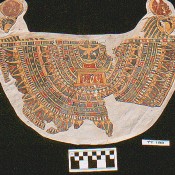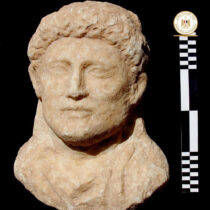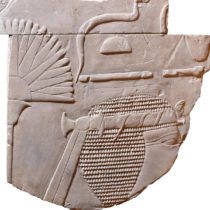Object W1013 is a mummy from Egypt, housed in the Swansea University’s Egypt Centre, Wales, UK, since 1971. Only measuring 52 cm. it is wrapped in a case made of cartonnage and painted in the style of a mummy from the 26th Dynasty (c. 600BC, the beginning of the Late Period), a human figure wearing a heavy blue and yellow striped wig and a wide collar. Inscriptions on the front and back of the mummy are mock hieroglyphic symbols.
It was this set of mock hieroglyphs that made archeologists believe that the mummy was actually a fake. Its dark past did not help. Being part of the Wellcome collection (5,000 Egyptian artefacts collected by 19th century pharmacist and amateur archaeologist Sir Henry Solomon Wellcome), its actual provenance and way of acquisition is unknown and lost forever. Back in 1998, an X-ray scan was done of the mummy by Singleton Hospital to offer a view within the mummy. But only now, a new examination demonstrated the truth.
A CT scan performed on the mummy by Swansea University’s Paola Griffiths of the Clinical Imaging College of Medicine, showing a dark area about 10cm long which appears to be a foetus and what could be a femur. In other words, the results are consistent with the remains of a baby!
Typical cartonnage mummies of babies had a hole in the back and under the feet, as, contrary to what was happening with the mummies of adults, where linen was wrapping a body, a plastered linen case would be made first, to accept the body of the dead baby finally. However, this baby seems to had been wrapped the way an adult was, as the case featured no holes. As for the mock hieroglyphs, they appear in several 21st Dynasty coffins from Saqqara, functioning possibly as a magical aid in the afterlife.
As a result, rather than being a fake, this mummy seems to just have been one of a cherished little person, who received appropriate care.
“It is sometimes claimed that because there were so many deaths of young children, as well as miscarriages, in the ancient world, that the ancients became ‘hardened’ to such tragedies. However, it is clear from the fact that foetuses and infants were buried with care, that such losses were not treated casually. We can imagine that the probable foetus within W1013 represents someone’s terrible loss; an occasion of great grief and public mourning.” said Egypt Centre curator Carolyn Graves-Brown.






